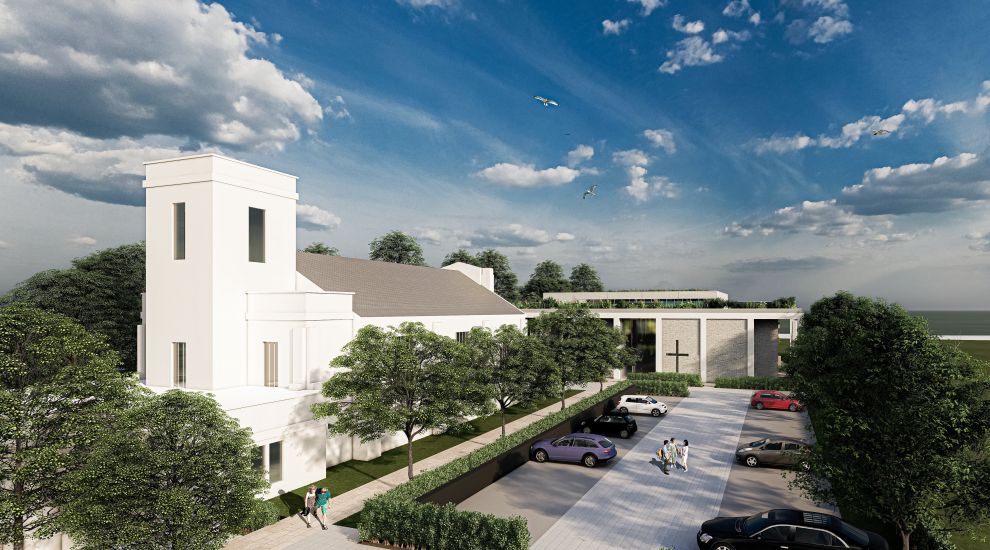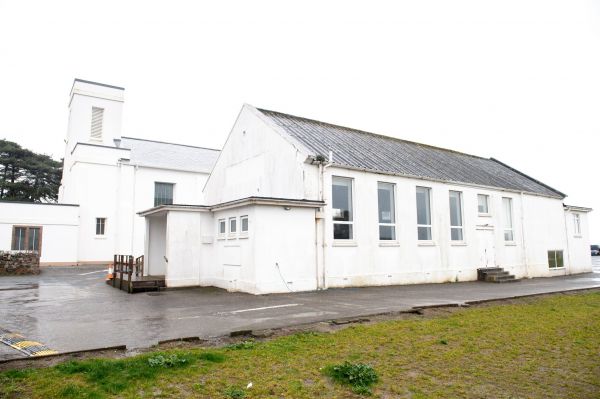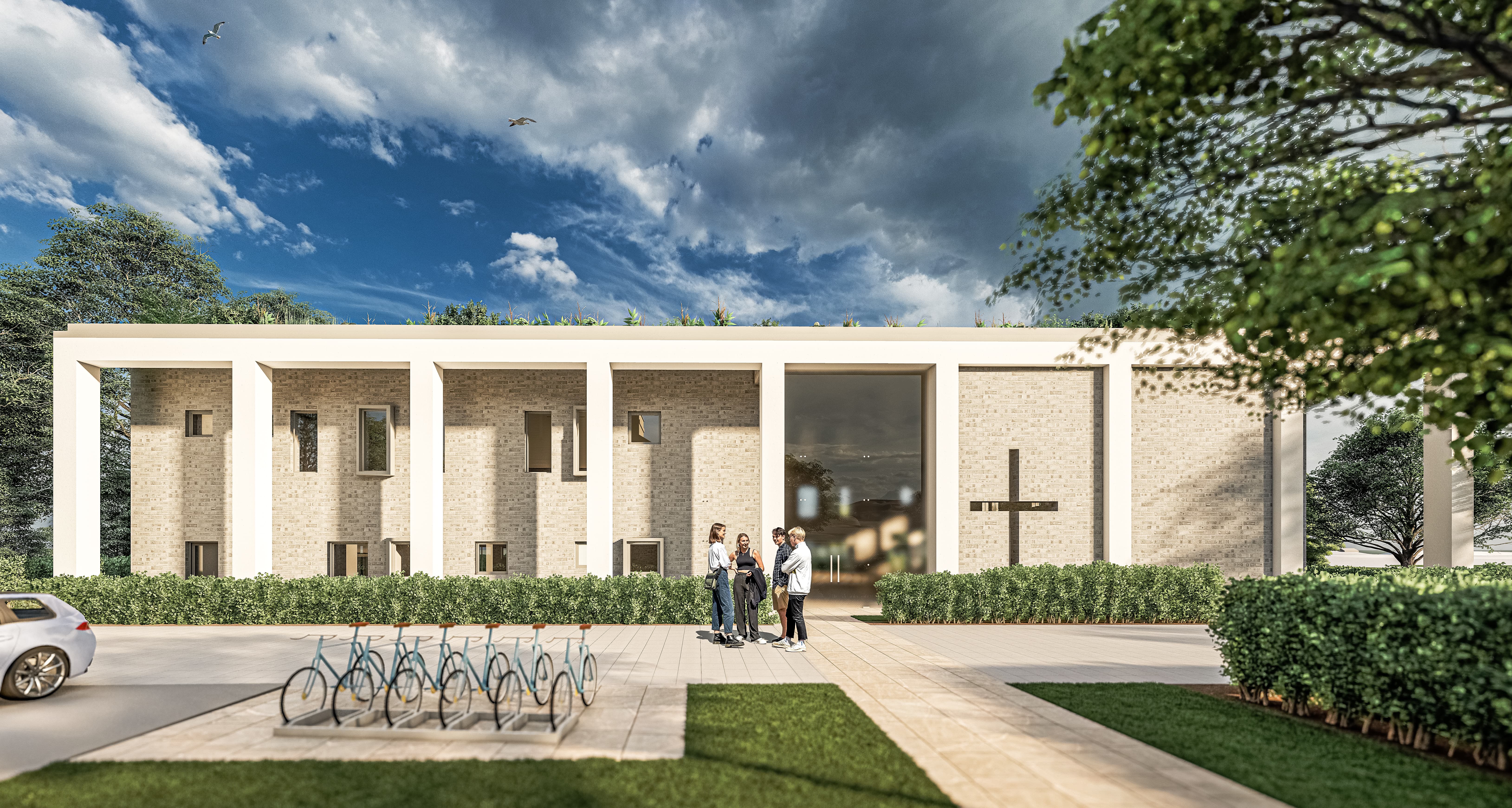


Plans have been put forward to demolish the hall at Jersey’s “world-renowned” Glass Church and its surrounding buildings and replace them with a ‘hope centre’ featuring a community hall, café, offices and two new homes after two years of consultation with members of the congregation and neighbours.
The main structure of St. Matthew's Glass Church was constructed in 1840 when a chapel was built for the growing population in the Millbrook area.
A Grade 1 Listed building, it is described on the island's historic buildings register as "one of the most interesting and significant twentieth century buildings in Jersey, representing a collaboration of the work of locally renowned modern movement architect, AB Grayson, and the world famous glass designer René Lalique."
However, Waddington Architects - who are behind the new plans - say the site is now "tired", and describe their proposals for a "calm building with an honesty about its appearance."

Pictured: The current Glass Church site.
Describing the changes, Mike Waddington said that the proposed work would include the demolition of old church hall, vicarage and outbuildings with the construction of a new church community hall – St Matthew’s Hope Centre – in its place.
"The new Hope Centre will include a community hall, cafe, offices and other community spaces along with parking facilities and landscaping. Two residential units are proposed," according to Mr Waddington.
The plans also include a proposal to create an access route from the Hope Centre to the adjoining Coronation Park.

Pictured: The proposed site. (Waddington Architects)
A spokesperson for St Matthew’s Church said: "St. Matthew’s Hope Centre has been carefully designed to be a centre of beauty, excellence, and communal benefit.
"Our vision is that this new centre will be at the heart of our Island community, for the community, serving the community and all who come to visit our world-renowned Church, with its Lalique glass."
The proposed changes would not alter the "external or interior’" fabric of the church, according to Waddington Architects, who added that it would continue to be used as an active place of worship.
A report prepared by RGA Consulting Engineers stated: "The Church Hall, constructed in 1954, exhibits a range of building fabric and structural defects which are largely the result of the construction methods used at the time which are now largely discredited."
It comes after Millbrook Playing Field was gifted to the public by a mystery benefactor who spent £700,000 to buy the field from the descendants of philanthropist Florence Boot - with a portion of the land going to the Glass Church community.
The government started a consultation on how the land should be used last year, and the results are yet to be published.
The full planning application for the church revamp - which has been graded as 'Major' - can be viewed here.
The island's protected buildings register sets out the key features of interest of the Glass Church as follows...
"The main structure of the church dates to 1840 when St. Matthew's was built as a chapel of ease for the growing population in the Millbrook area.
The church was extensively remodelled by Grayson in 1934 - the work commissioned by Florence Boot, Lady Trent, as a memorial to her late husband Jesse Boot, 1st Baron Trent of Nottingham (founder of the Boots Company).
Grayson refashioned the exterior of the church in International Style with plain walls and the strong use of geometric shapes (a Granosite finish was applied to the walls in the 1960s). To the front of the church is a gateway with dressed granite pillars and geometric patterned metal gates. Grayson's unity of design and architectural vision extended to remodelling of the church interior, and the design of the 1930s fittings.
A variety of stonework is used - the floor paved with Portland stone, the walls faced with Bath stone and the floor in the Chancel of Dorset stone - with the pews, doors and other joinery of English oak, and the Lectern and Pulpit built of Hopton Wood stone from Derbyshire. The interior of the church is fitted and decorated throughout by exceptional glasswork designed and made by Lalique - St. Matthew's having the distinction as the only church where Lalique decorated throughout. The glasswork includes a great Cross flanked by two pillars behind the altar, a communion rail, screens and windows decorated with the Madonna lily and Jersey lily, and a chalice-shaped font.
The reredos of the Lady Chapel is composed of four glass angels that recur as panels in the main doors. The church is lit by massive ceiling light troughs also of Lalique glass, and there are smaller glass lamps within the north porch. To the north of the church is a 1930s gateway which adds interest to the overall composition. The dilapidated garages within the boundary are not of interest."
Comments
Comments on this story express the views of the commentator only, not Bailiwick Publishing. We are unable to guarantee the accuracy of any of those comments.